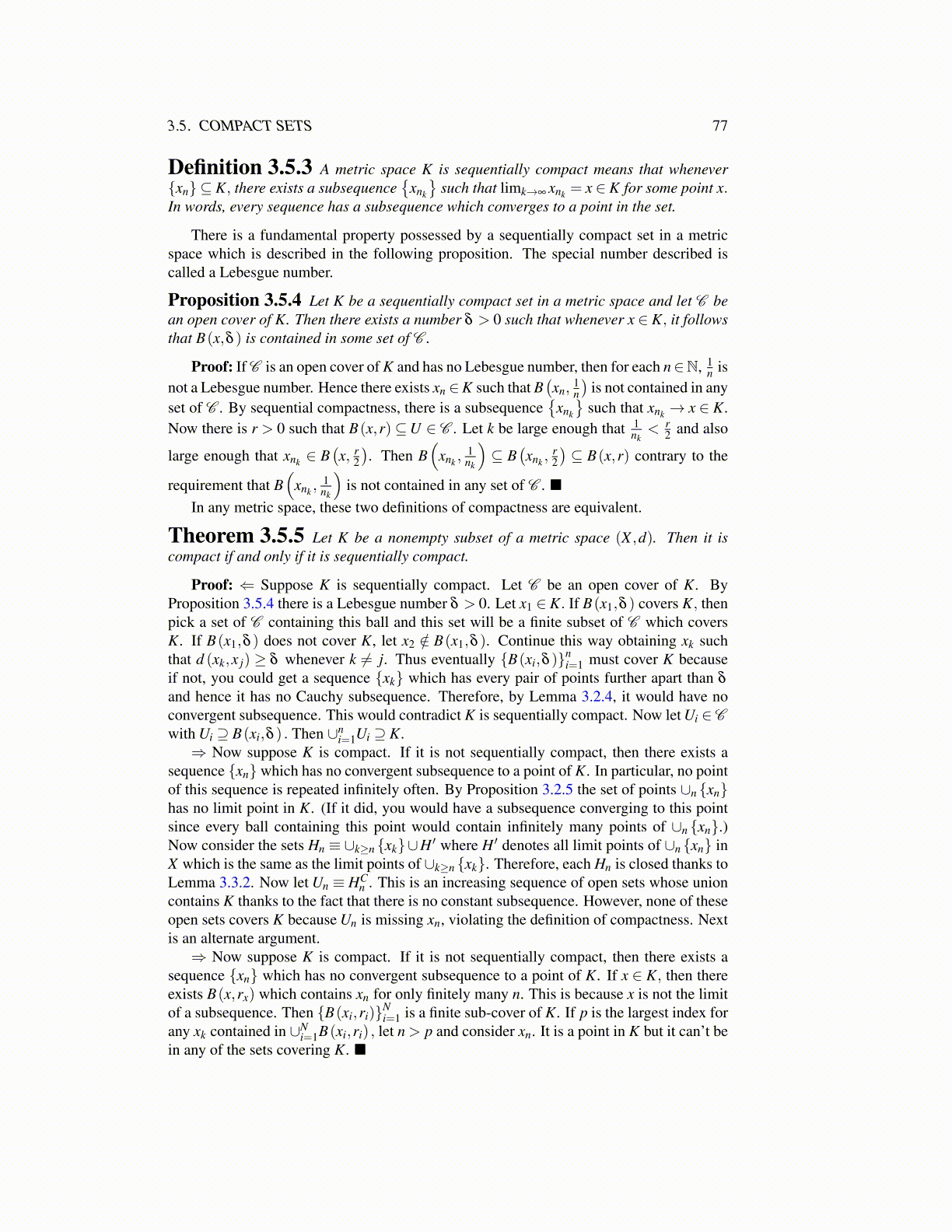
3.5. COMPACT SETS 77
Definition 3.5.3 A metric space K is sequentially compact means that whenever{xn} ⊆ K, there exists a subsequence
{xnk
}such that limk→∞ xnk = x ∈ K for some point x.
In words, every sequence has a subsequence which converges to a point in the set.
There is a fundamental property possessed by a sequentially compact set in a metricspace which is described in the following proposition. The special number described iscalled a Lebesgue number.
Proposition 3.5.4 Let K be a sequentially compact set in a metric space and let C bean open cover of K. Then there exists a number δ > 0 such that whenever x ∈ K, it followsthat B(x,δ ) is contained in some set of C .
Proof: If C is an open cover of K and has no Lebesgue number, then for each n∈N, 1n is
not a Lebesgue number. Hence there exists xn ∈K such that B(xn,
1n
)is not contained in any
set of C . By sequential compactness, there is a subsequence{
xnk
}such that xnk → x ∈ K.
Now there is r > 0 such that B(x,r)⊆U ∈ C . Let k be large enough that 1nk
< r2 and also
large enough that xnk ∈ B(x, r
2
). Then B
(xnk ,
1nk
)⊆ B
(xnk ,
r2
)⊆ B(x,r) contrary to the
requirement that B(
xnk ,1nk
)is not contained in any set of C . ■
In any metric space, these two definitions of compactness are equivalent.
Theorem 3.5.5 Let K be a nonempty subset of a metric space (X ,d). Then it iscompact if and only if it is sequentially compact.
Proof: ⇐ Suppose K is sequentially compact. Let C be an open cover of K. ByProposition 3.5.4 there is a Lebesgue number δ > 0. Let x1 ∈ K. If B(x1,δ ) covers K, thenpick a set of C containing this ball and this set will be a finite subset of C which coversK. If B(x1,δ ) does not cover K, let x2 /∈ B(x1,δ ). Continue this way obtaining xk suchthat d (xk,x j) ≥ δ whenever k ̸= j. Thus eventually {B(xi,δ )}n
i=1 must cover K becauseif not, you could get a sequence {xk} which has every pair of points further apart than δ
and hence it has no Cauchy subsequence. Therefore, by Lemma 3.2.4, it would have noconvergent subsequence. This would contradict K is sequentially compact. Now let Ui ∈Cwith Ui ⊇ B(xi,δ ) . Then ∪n
i=1Ui ⊇ K.⇒ Now suppose K is compact. If it is not sequentially compact, then there exists a
sequence {xn} which has no convergent subsequence to a point of K. In particular, no pointof this sequence is repeated infinitely often. By Proposition 3.2.5 the set of points ∪n {xn}has no limit point in K. (If it did, you would have a subsequence converging to this pointsince every ball containing this point would contain infinitely many points of ∪n {xn}.)Now consider the sets Hn ≡ ∪k≥n {xk}∪H ′ where H ′ denotes all limit points of ∪n {xn} inX which is the same as the limit points of ∪k≥n {xk}. Therefore, each Hn is closed thanks toLemma 3.3.2. Now let Un ≡ HC
n . This is an increasing sequence of open sets whose unioncontains K thanks to the fact that there is no constant subsequence. However, none of theseopen sets covers K because Un is missing xn, violating the definition of compactness. Nextis an alternate argument.⇒ Now suppose K is compact. If it is not sequentially compact, then there exists a
sequence {xn} which has no convergent subsequence to a point of K. If x ∈ K, then thereexists B(x,rx) which contains xn for only finitely many n. This is because x is not the limitof a subsequence. Then {B(xi,ri)}N
i=1 is a finite sub-cover of K. If p is the largest index forany xk contained in ∪N
i=1B(xi,ri) , let n > p and consider xn. It is a point in K but it can’t bein any of the sets covering K. ■